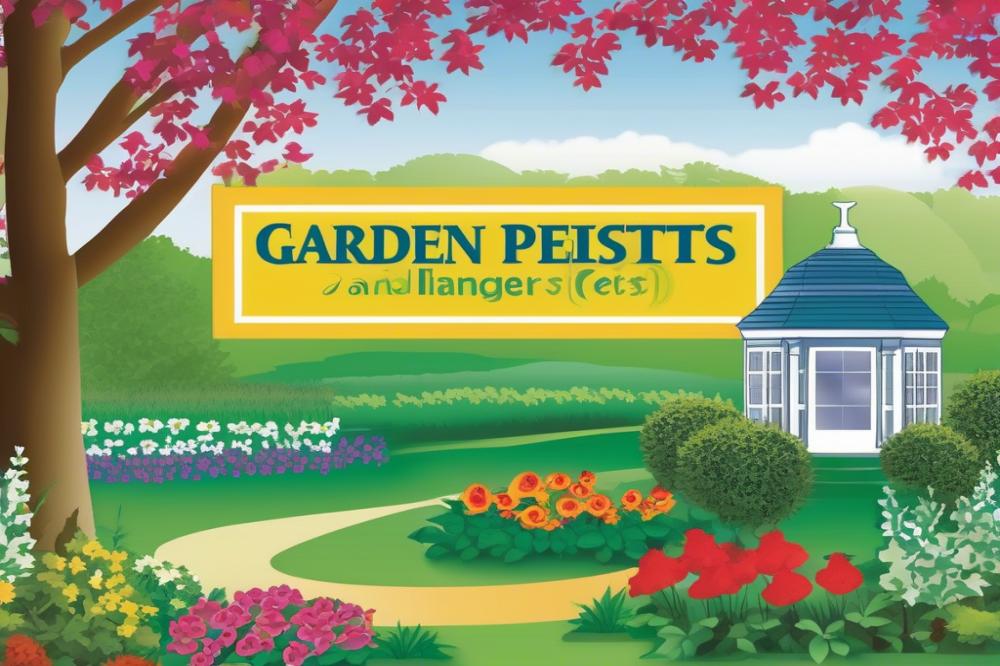Understanding Garden Pest Management
Garden pest management is crucial for anyone who loves cultivating plants. Protecting your plants from harm is not just about keeping a beautiful yard; it’s also about maintaining healthy ecosystems. Pests can quickly become a significant threat to plant health, causing problems that can spread beyond an individual plant. One of the more common threats faced by gardeners is the presence of leaf miners. These pests burrow into foliage, leaving unsightly trails and damaging the plants’ ability to photosynthesize effectively.
Focusing on prevention methods is essential for effective horticulture. Many gardeners prefer organic gardening techniques that work in harmony with nature. Utilizing natural remedies can help in maintaining a balance, making conditions less favorable for pests. Regular garden maintenance plays a vital role in this process. By providing strong foliage protection, plant resilience increases, making it harder for pests to establish themselves.
In addition to effective management techniques, beneficial insects can play a significant role in reducing pest populations. Forcing pests like leaf miners out of the garden requires a thoughtful combination of strategies. Regular monitoring and recognizing warning signs can help address issues before they escalate. Integrating pest control solutions, alongside plant care, sets a solid foundation for a thriving garden. By embracing these strategies, gardeners can protect their plants while enjoying the fruits of their labor.
Understanding Leaf Miners


Leaf miners are small insects that create distinctive patterns in plant leaves. They belong to several different species, and they usually start as eggs laid on the surface of leaves. After hatching, the larvae burrow into the foliage, feeding on the inner leaf tissue. This feeding creates visible trails that disrupt normal photosynthesis.
The damage can lead to significant problems for plants. When a plant loses its foliage, it struggles to produce energy, resulting in stunted growth. Affected areas may turn yellow or brown, and in severe cases, entire leaves die off, reducing the plant’s overall health. This decline can even make plants more susceptible to other pests and diseases.
Certain species are more susceptible to these pests than others. Vegetables like spinach, lettuce, and chard are commonly affected. Additionally, ornamental plants such as azaleas and various types of shrubs often show signs of infestations. This can be frustrating for gardeners who invest time in caring for their plants.
To protect your garden, it is important to implement pest control measures. organic gardening methods can help reduce damage while maintaining plant health. Consider introducing beneficial insects, such as ladybugs, which naturally prey on pests. Additionally, natural remedies like neem oil can be effective against these larvae.
Regular garden maintenance is crucial. Inspect plants frequently to catch early signs of an infestation. You can also apply insecticides when necessary, but use them with caution to avoid harming beneficial insects. Creating a healthy garden ecosystem will improve foliage protection and decrease the likelihood of pest problems in the future.
Prevention methods play a key role in an effective gardening strategy. Maintaining good air circulation and proper watering helps plants stay healthy and more resilient against pests. With careful management, you can keep these unwanted visitors from disrupting your garden experience.
Signs of Leaf Miner Infestation


Identifying the signs of a leaf miner infestation is crucial for protecting your garden. Typically, damage appears as winding, serpentine trails on the leaves. These trails are the result of larvae burrowing into the plant tissue. Affected foliage may also show yellowing or browning as the plant struggles with its health.
Another clear indicator is the presence of small, dark dots, which are the frass or waste produced by the larvae. These signs often resemble other pest damage but pay attention to the patterns. Other insects, like aphids or spider mites, do not create such distinct trails. Instead, they may cluster on the undersides of leaves or cause stippling damage.
Importance of Early Detection
Early detection can significantly improve your chances of effective pest control. Catching the problem in its early stage allows for more options in treatment. If left unchecked, these pests can cause extensive damage, ultimately affecting plant health and productivity.
Gardeners practicing organic gardening should monitor for these signs regularly. Incorporating routine inspection into your maintenance schedule can be beneficial. If a plant shows mild signs of infestation, organic solutions like natural remedies or beneficial insects could help manage the issue effectively.
Using insecticides is sometimes necessary when damage escalates. However, it is essential to read labels carefully. Many products can harm beneficial insects that are crucial for horticulture. Balancing control measures while preserving ecosystem health is vital.
In summary, familiarizing yourself with the visual symptoms of damage is the first step in prevention methods. Quick action can protect your valuable plants from greater harm. Stay vigilant and proactive for the best results in your garden.
Prevention Methods


Keeping pests at bay is essential for a thriving garden. Effective prevention methods can save your plants from damage. Regular garden maintenance plays a significant role in reducing infestations. Healthy plants are better equipped to resist pests.
Start by monitoring your plants consistently for any signs of trouble. Early detection can stop an invasion before it starts. Remove any affected leaves promptly to prevent pests from spreading. Healthy foliage promotes plant health and reduces the risk of infestations.
Implementing protective measures can also be a game changer. Row covers serve as a physical barrier against pests. Lightweight fabrics allow air and light but keep harmful insects out. Use them especially during peak flying times for insects that cause damage.
Barriers such as copper tape or sticky traps can deter pests effectively. Integrating these tools into your garden can create a less inviting environment for unwanted visitors. Encouraging beneficial insects is another smart strategy. These allies help keep pest populations in check, contributing to a balanced ecosystem.
When considering pest control options, you might lean towards organic gardening practices. Natural remedies, like neem oil or insecticidal soap, can be effective against various threats. Using these alternatives minimizes harm to the environment and promotes a healthier garden.
Regular maintenance tasks also contribute to a stronger defense against pests. Keeping the garden clean and debris-free reduces hiding spots. Prune dead or infected branches, as these can attract unwanted insects. A tidy garden not only looks appealing but also discourages infestations.
Choosing the right plants is crucial, too. Some varieties are more resistant to pests than others. Research the plants that suit your climate and conditions for optimal growth. Diversifying your plant selections can confuse pests, making it harder for them to find their preferred hosts.
In conclusion, a proactive approach to gardening prevents issues before they arise. Each step taken in garden maintenance and protective measures contributes to a more resilient ecosystem. Using a combination of tactics ultimately leads to healthier and more productive plants.
Pest Control Options


Managing pests can be a challenging aspect of gardening. Leaf miner outbreaks can cause significant damage, but there are various strategies available to help protect your plants. Understanding the different pest control methods allows gardeners to choose the best approach for their needs.
Insecticides are one way to combat these pests. They can effectively eliminate leaf miners when used appropriately. However, one must be cautious. Many insecticides also target beneficial insects that play vital roles in maintaining plant health. Bees, ladybugs, and other helpful species can suffer collateral damage when broad-spectrum insecticides are applied. This imbalance can lead to long-term challenges within your garden.
Organic Gardening Solutions
Organic gardening offers an alternative to chemical treatments. Using natural remedies can be safer for your garden’s ecosystem. For instance, introducing predatory insects, such as parasitic wasps, can help control populations of harmful pests. Additionally, maintaining healthy foliage through proper nutrition and care encourages plants to withstand minor infestations.
Prevention methods are also essential. Regular inspections can catch pests early and limit their spread. Good garden maintenance, such as removing affected leaves and keeping your plants clean, can greatly reduce the chances of infestation. Cover crops and companion planting can deter pests naturally while promoting overall horticulture health.
Some gardeners turn to homemade sprays made from ingredients like garlic or hot pepper. These solutions can deter pests without harming beneficial insects. They serve as a proactive measure rather than a reactive one, helping to create a balanced environment in your garden.
In summary, different pest control options exist to manage leaf miners effectively. Each method, whether chemical or organic, has its own merits and drawbacks. Choose wisely to maintain a vibrant and healthy garden.
Natural Remedies for Leaf Miners
Finding natural remedies is a key step in managing the leaf miner problem in gardens. Many gardeners seek simpler solutions that align with organic gardening principles. One effective method involves the application of homemade sprays using ingredients like garlic or hot pepper. These mixtures can deter pests without resorting to harsh insecticides.
Beneficial insects serve as powerful allies in pest control. Ladybugs and lacewings, for example, are known to feed on small caterpillars that cause damage to plants. By attracting these helpful insects to your garden, you can reduce harmful populations naturally. Planting flowers such as marigolds increases the chances of beneficial insects visiting.
Maintaining a balanced ecosystem is crucial for plant health. Soil health, plant diversity, and encouraging pollinators can go a long way in preventing pest issues. Companion planting is another effective strategy. By grouping compatible plants together, you can naturally deter unwanted pests.
Regular garden maintenance supports foliage protection. Routinely inspecting plants allows early detection of any signs of distress. Removing affected leaves promptly can minimize potential damage. This proactive approach is essential in the battle against pests.
Ultimately, understanding your garden’s unique environment helps improve prevention methods. Rather than seeing pests as a nuisance, view them as part of the ecological balance. Knowledge of local species can guide you in selecting the best strategies for effective horticulture.
The Role of Monitoring and Maintenance
Regular monitoring plays a critical role in preventing damage from pests. Keeping an eye out for any signs of activity can help gardeners take timely action. Look for small holes in leaves or the telltale trails left behind. These may indicate that a pest is present. Noticing these signs early can save your plants.
Maintaining plant health should not be overlooked. Healthy plants are naturally more resilient. They can withstand various stresses, including pest attacks. Proper watering, fertilizing, and providing enough sunlight all contribute to strong foliage. Use organic gardening practices whenever possible. They help nurture soil health and, in turn, plant vitality.
Taking a proactive approach to pest management is key in horticulture. Instead of reacting after damage has occurred, initiate prevention methods. Regular garden maintenance is essential. This may involve removing debris or weeds that harbor pests. Consider introducing beneficial insects that prey on harmful species. Ladybugs and lacewings can be effective allies in your garden battle.
When pests do appear, evaluate your options. Insecticides can be effective but should be used judiciously. Always read labels carefully and follow instructions. For those looking for alternatives, explore natural remedies. Neem oil or insecticidal soaps are commonly used in organic gardening. They can provide a solution without the harsh chemicals found in some products.
Foliage protection is a vital aspect of prevention. Creating barriers can keep pests away from vulnerable plants. Floating row covers may also be useful. These allow sunlight and moisture in while shielding plants from harmful insects. Remember, taking action before a problem arises is often the best strategy.
Wrapping Up
Key points from this discussion emphasize the importance of prevention methods. Understanding the life cycle of these pests helps in protecting your plants effectively. Regularly inspecting foliage can catch issues before they multiply. Additionally, using barriers like row covers can be a simple yet efficient way to shield vulnerable crops.
Encouraging readers to consider integrated pest management is vital for maintaining a healthy garden. This strategy combines different methods, promoting natural balance while minimizing chemical use. Organic gardening practices can also support this approach, fostering a more sustainable environment.
By being proactive, gardeners can safeguard their plants while enjoying a flourishing garden. This effort not only protects individual plants but also contributes to a thriving ecosystem. Effective pest control is not merely a chore; it is a commitment to responsible gardening that many can appreciate. Embrace these techniques, and watch your garden thrive.



